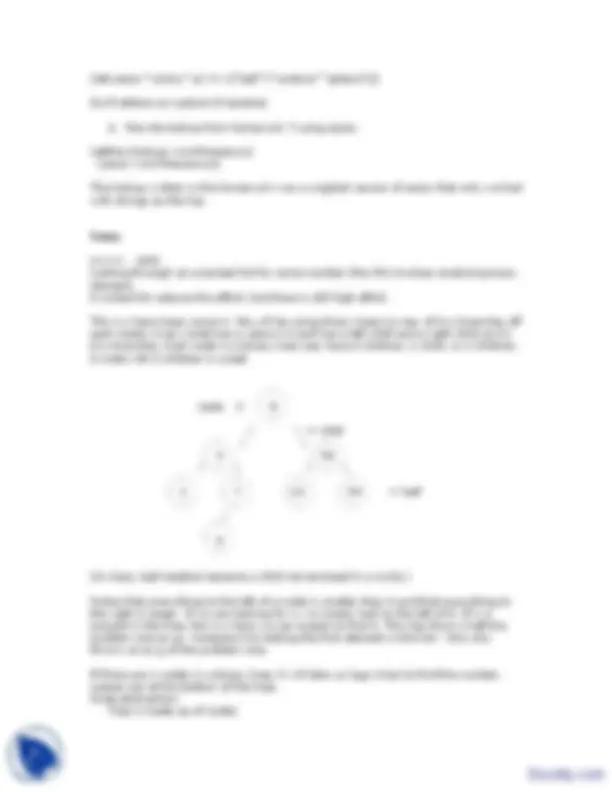




Study with the several resources on Docsity

Earn points by helping other students or get them with a premium plan


Prepare for your exams
Study with the several resources on Docsity

Earn points to download
Earn points by helping other students or get them with a premium plan
Community
Ask the community for help and clear up your study doubts
Discover the best universities in your country according to Docsity users
Free resources
Download our free guides on studying techniques, anxiety management strategies, and thesis advice from Docsity tutors
Some concept of Building Programming Experience are Trees, Square Limit Language, Special Forms, Quizanssheet, Professor Abstraction, Compound Procedure, Procedures And Recursion. Main points of this lecture are: Trees, Contains, Professors, Graduate Students, Program, Abstraction Violation, Predicate Primitive, Primitive Procedures, Boolean Depending, Lecture
Typology: Slides
1 / 4

This page cannot be seen from the preview
Don't miss anything!



Lecture 8: Tags, Alists, Trees
From the Lecture 8 handout, directions are:
Given a list that contains both professors and graduate students, compute the total cost of their salaries.
The following program may be written to satisfy these instructions:
(define (total-cost people-list) (if (null? people-list) 0 (+ (second (car people-list)) (total-cost (cdr people-list)))))
abstraction violation! (using second on a professor or a student)
Several predicate primitive procedures were named:
(number? x) returns a Boolean depending on whether or not x is a number (string? x) does the same to check for a string (pair? x) checks to see if x is a box; nil does not satisfy this procedure with true (list? x) is it a string of boxes ending in nil? nil itself satisfies this predicate
The “theme” of the lecture was “You will see these topics again in 6.001”
Tagging a list is a standard way of making lists: (define (make-professor name salary) (list “professor” name salary)) “professor” is the tag part of the list
Professor-name is now defined as the second of the list make-professor Professor-salary is now defined as the third
(as opposed to first and second, respectively)
(define professor? x) (and (pair? x) (string? “professor” (car x))))
(We can’t use list? above because nil is a list and that will cause the program to crash when it reaches the procedure car.)
Using the constructors and selectors that we created on the Lecture 8 handout, we can make contracts:
(define (total-cost people) (if (null? people) 0 (+ (if (professor? (car people)) (professor-salary (car people)) (gradstudent-salary (car people))) (total-cost (cdr people)))))
Association Lists
aÆ((“victory” (“triumph” “win”)) (“ball” (“rondure” “sphere”)))
a is the alist (assoc “victory” a) => (“victory” (“triumph” “win”))
(assoc “defeat” a) => #f
bÆ((1 #t) (2 #f) (3 #t) (4 #f))
assoc returns the entire entry rather than simply the associated value for the sake of clarity. The following is a list of assoc commands and what is actually returned. After that is a list of the same assoc commands intended for counter example.
Actual:
(assoc 3 b) ;Value: (3 #t) (assoc 2 b) ;Value: (2 #f) (assoc 54 b) ;Value: #f
Counterexample (if only the associated value were returned):
(assoc 3 b) ;Value: #t (assoc 2 b) ;Value: #f (assoc 54 b) ;Value: #f
If only associated the value is returned, we cannot tell in a case such as the above whether the associated value is #f or whether the key itself is not a part of alist. (It would be good to note that when an key cannot be found in alist, the return value of assoc is #f.)
We can build an association and add it to a previous list as follows: (cons (list 0 #t) b)
List is made up of pairs A tree is either a leaf or a node, by definition. 12 is a valid tree. The simplest tree is a leaf: no nodes, no decision.
Define the procedures listed under “Trees” on the Lecture 8 handout. Solutions are posted on the site under Lecture 8 Solutions.
For question 3, the idea is to preserve the already-existing leaves and nodes, but insert a new element in its proper place. This involves methodically breaking apart the entire tree and building it back up (with your procedure).
The last portion of the lecture involved the Animal Guessing Game. The instructions are listed under “Animal Guessing Game” on the Lecture 8 handout. (This involves downloading lec8.scm from the server on your computer)
A procedure defined in class:
(define (new-list-guesser knowledge) (if (null? knowledge) (begin (print-msg “I give up”) nil) (if (ask-about-animal (car knowledge)) (begin (print-msg “Yay!”) knowledge) (cons (car knowledge) (new-list-guesser (cdr knowledge))))))
Discussion suggested replacing nil above with a return of “improve-knowledge”, where we would implement a procedure to add an animal to the computer’s bank of knowledge. This would improve the game a little.